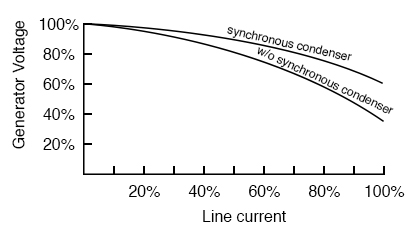Synchronous motors load the power line with a leading power factor. This is often useful in canceling out the more commonly encountered lagging power factor caused by induction motors and other inductive loads. Originally, large industrial synchronous motors came into wide use because of this ability to correct the lagging power factor of induction motors.
This leading power factor can be exaggerated by removing the mechanical load and overexciting the field of the synchronous motor. Such a device is known as a synchronous condenser. Furthermore, the leading power factor can be adjusted by varying the field excitation. This makes it possible to nearly cancel an arbitrary lagging power factor to unity by paralleling the lagging load with a synchronous motor. A synchronous condenser is operated in a borderline condition between a motor and a generator with no mechanical load to fulfill this function. It can compensate either a leading or lagging power factor, by absorbing or supplying reactive power to the line. This enhances the power line voltage regulation.
Since a synchronous condenser does not supply a torque, the output shaft may be dispensed with and the unit easily enclosed in a gas-tight shell. The synchronous condenser may then be filled with hydrogen to aid cooling and reduce windage losses. Since the density of hydrogen is 7% of that of air, the windage loss for a hydrogen-filled unit is 7% of that encountered in air. Furthermore, the thermal conductivity of hydrogen is ten times that of air. Thus, heat removal is ten times more efficient. As a result, a hydrogen-filled synchronous condenser can be driven harder than an air-cooled unit, or it may be physically smaller for a given capacity. There is no explosion hazard as long as the hydrogen concentration is maintained above 70%, typically above 91%.
The efficiency of long power transmission lines may be increased by placing synchronous condensers along the line to compensate lagging currents caused by line inductance. More real power may be transmitted through a fixed size line if the power factor is brought closer to unity by synchronous condensers absorbing reactive power.
The ability of synchronous condensers to absorb or produce reactive power on a transient basis stabilizes the power grid against short circuits and other transient fault conditions. Transient sags and dips of milliseconds duration are stabilized. This supplements longer response times of quick-acting voltage regulation and excitation of generating equipment. The synchronous condenser aids voltage regulation by drawing leading current when the line voltage sags, which increases generator excitation thereby restoring line voltage. A capacitor bank does not have this ability.

Synchronous condenser improves power line voltage regulation